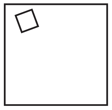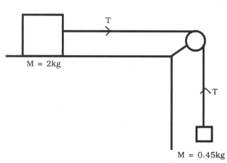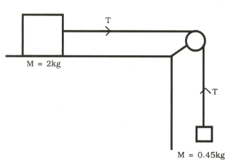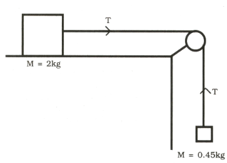Telangana Board Solutions for Chapter: Laws of Motion, Exercise 1: EXERCISES
Telangana Board Physics Solutions for Exercise - Telangana Board Solutions for Chapter: Laws of Motion, Exercise 1: EXERCISES
Attempt the free practice questions on Chapter 5: Laws of Motion, Exercise 1: EXERCISES with hints and solutions to strengthen your understanding. Intermediate First Year Physics solutions are prepared by Experienced Embibe Experts.
Questions from Telangana Board Solutions for Chapter: Laws of Motion, Exercise 1: EXERCISES with Hints & Solutions
A fixed pulley with a smooth groove has a light string passing over it with a attached on one side and a on the other side. Another is hung from the other as shown with another light string. If the system is released from rest, find the common acceleration (in ).
(Take, )

A block of mass 2 kg slides on an inclined plane that makes an angle of 30 degree with the horizontal. The coefficient of friction between the block and the surface is . What force (in Newton) should be applied to the block so that it moves down without any acceleration? ()
A block of mass 2 kg slides on an inclined plane that makes an angle of 30 degree with the horizontal. The coefficient of friction between the block and the surface is . What force (in Newton) should be applied to the block so that it moves up without any acceleration? ()
A block is placed on a ramp of parabolic shape given by the equation . If , what is the maximum height above the ground at which the block can be placed without slipping?

A block of metal of mass on a horizontal table is attached to a mass of by a light string passing over a frictionless pulley at the edge of the table.The block is subjected to a horizontal force by allowing the mass to fall. The coefficient of sliding friction between the block and table is . Calculate the initial acceleration (in ). ()

A block of metal of mass on a horizontal table is attached to a mass of by a light string passing over a frictionless pulley at the edge of the table.The block is subjected to a horizontal force by allowing the mass to fall. The coefficient of sliding friction between the block and table is . Calculate the tension (in Newton) in the string. ()

A block of metal of mass on a horizontal table is attached to a mass of by a light string passing over a frictionless pulley at the edge of the table.The block is subjected to a horizontal force by allowing the mass to fall. The coefficient of sliding friction between the block and table is . Calculate the distance (in metres) the block would continue to move if, after seconds of motion, the string should break. ()

On a smooth horizontal surface a block A of mass is kept. On this block a second block B of mass is kept. The coefficient of friction between the two blocks is . A horizontal force of is applied on the lower block as shown. The force of friction between the blocks is
()

